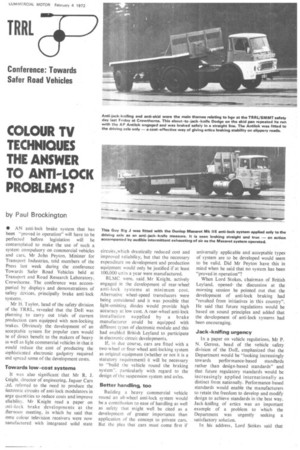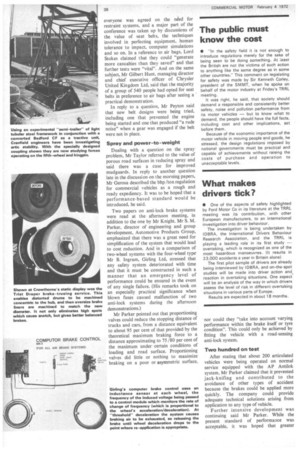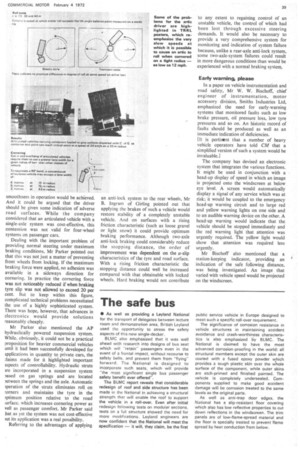COLOUR TV TECHNIQUES THE ANSWER TO ANTI-LOCK PROBLEMS?
Page 39

Page 40

Page 41

If you've noticed an error in this article please click here to report it so we can fix it.
by Paul Brockington • AN anti-lock brake system that has been "proved in operation" will have to be perfected before legislation will be contemplated to make the use of such a system compulsory on commercial vehicles and cars, Mr John Peyton, Minister for Transport Industries, told members of the Press last week during the conference Towards Safer Road Vehicles held at Transport and Road Research Laboratory,. Crowthorne. The conference was accompanied by displays and demonstrations of safety devices, principally brake anti-lock Systems.
Mr H. Taylor, head of the safety division of the TRRL, revealed that the DoE was planning to carry out trials of current production cars equipped with non-locking brakes. Obviously the development of an acceptable system for popular cars would be of direct benefit to the makers of heavy is well as light commercial vehicles in that it would reduce the cost of producing the ;ophisticated electronic gadgetry required Ind spread some of the development costs.
Towards low-cost systems It was also significant that Mr R. J. .night. director of engineering, Jaguar Cars referred to the need to produce the :lectronic circuits of anti-lock modulators in arge quantities to reduce costs and improve eliabilitv. Mr Knight read a paper on inti-lock brake developments at the ifternoon meeting, in which he said that ome colour television receivers were now nanufactured with integrated solid state
circuits.which drastically reduced cost and improved reliability, but that the necessary
expenditure on development and production equipment would only be justified if at least 100,000 units a year were manufactured.
BLMC were, said Mr Knight, actively engaged in the development of rear-wheel anti-lock systems at minimum cost. Alternative wheel-speed transducers were being considered and it was possible that light-emitting diodes would provide high accuracy at low cost. A rear-wheel anti-lock installation supplied by a brake manufacturer could be equipped with different types of electronic module and this had enabled British Leyland to participate in electronic circuit developments.
If, in due course, cars are fitted with a two-wheel or four-wheel anti-locking system as original equipment (whether or not it is a statutory requirement) it will be necessary to "build the vehicle round the braking System-, particularly with regard to the design of the suspension system and axles.
Better handling, too
-Building a heavy commercial vehicle round an all-wheel anti-lock system would be a contribution to ease of handling as well as safety that might well be cited as a development of greater importance than application of the concept to private cars. But the plea that cars must come first if universally applicable and acceptable types of system are to be developed would seem to be valid. Did Mr Peyton have this in mind when he said that no system has been "proved in operation"?
When Lord Stokes, chairman of British Leyland. opened: the discussion at the morning session he pointed out that the development of anti-lock braking had "resulted from initiatives in this country". He said that future regulations would be based on sound principles and added that the development of anti-lock systems had been encouraging.
Jack-knifing urgency
In a paper on vehicle regulations, Mr P. N. Gerosa, head of the vehicle safety division of the DoE, emphasized that the Department would be "looking increasingly
towards performance-based standards rather than design-based standards" and that future regulatory standards would be increasingly applied internationally as distinct from nationally. Performance-based standards would enable the manufacturers to retain the freedom to develop and modify design to achieve standards in the best way. Jack-knifing of artics was an important example of a problem to -which the Department was urgently seeking a Satisfactory solution.
In his address, Lord Stokes said that everyone was agreed on the flied for restraint systems, and a major part of the conference was taken up by discussions of the value of seat belts, the techniques involved in perfecting equipment, human tolerance to impact, computer simulations and so on. In a reference to air bags, Lord Stokes claimed that they could "generate more casualties than they saved" and that further tests were "vital". And on the same subject, Mr Gilbert Hunt, managing director and chief executive officer of Chrysler United Kingdom Ltd, said that the majority of a group of 540 people had opted for seat belts in preference to air bags after seeing a practical demonstration.
In reply to a question, Mr Peyton said that new belt designs were being tried, including one that prevented the engine being started and one that produced "a rude noise" when a gear was engaged if the belt were not in place.
Spray and power-to-weight
Dealing with a question on the spray problem, Mr Taylor referred to the value of porous road surfaces in reducing spray and said there was a case for improved mudguards. In reply to another question late in the discussion on the morning papers, Mr Gerosa described the bhp /ton regulation for commercial vehicles as a rough and ready expediency. It was to be hoped that a performance-based standard would be introduced, he said.
Two papers on anti-lock brake systems were read at the afternoon meeting, in addition to the one by Mr Knight. Mr S. M. Parker, director of engineering and group development, Automotive Products Group, emphasized that there was a great need for simplification of the system that would lead to cost reduction. And in a comparison of two-wheel systems with the four-wheel type Mr B. Ingram, Girling Ltd, stressed that any safety system deteriorated with time and that it must be constructed in such a manner that an emergency level of performance could be ensured in the event of any single failure. (His remarks took on an especially practical significance when blown fuses caused malfunction of two anti-lock systems during the afternoon demonstrations.) Mr Parker pointed out that proportioning valves could reduce the stopping distance of trucks and cars, from a distance equivalent to about 95 per cent of that provided by the theoretical maximum braking force to a distance approximating to 75/80 per cent of the maximum under certain conditions of loading and road surface. Proportioning valves did little or nothing to maximize braking on a poor or asymmetric surface, nor could they "take into account varying performance within the brake itself or tyre condition", This could only be achieved by fitting the vehicle with a road-sensing anti-lock system.
Two hundred on test After stating that about 200 articulated vehicles were being operated on normal service equipped with the AP Antilok system, Mr Parker claimed that it prevented jack-knifing and contributed to the avoidance of other types of accident because the brakes could be applied more quickly. The company could provide adequate technical solutions arising from application to any type of vehicle.
Further intensive development was continuing said Mr Parker. While the present standard of performance was acceptable, it was hoped that greater smoothness in operation would be achieved. And it could be argued that the driver should be given some indication of adverse road surfaces. While the company considered that an articulated vehicle with a single-axle system was cost-effective, this contention was not valid for four-wheel systems on passenger cars.
Dealing with the important problem of providing normal steering under maximum braking conditions, Mr Parker pointed out that this was not just a matter of preventing front wheels from locking. If the maximum braking force were applied, no adhesion was available in a sideways direction for cornering. In practice the cornering force was not noticeably reduced if when braking tyre slip was not allowed to exceed 20 per cent. But to keep within this figure, complicated technical problems necessitated the use of a highly sophisticated system. There was hope, however, that advances in electronics would provide solutions reasonably cheaply.
Mr Parker also mentioned the AP hydraulically powered suspension system. While, obviously, it could not be a practical proposition for heavier commercial vehicles until it had been successfully developed for ipplications in quantity to private cars, the :laims made for it highlighted important ispects of controllability. Hydraulic struts ire incorporated in a suspension system )ased on gas springs and are located )etween the springs and the axle. Automatic )peration of the struts eliminates roll on ;orners and maintains the tyre in the )ptimum position relative to the road ;urfacc, which increases cornering power as well as passenger comfort. Mr Parker said hat as yet the system was not cost-effective nrt its application was a real possibility.
Referring to the advantages of applying an anti-lock system to the rear wheels, Mr B. Ingram of Girling pointed out that applying the brakes of such a vehicle would restore stability of a completely unstable vehicle. And on surfaces with a rising friction characteristic (such as loose gravel or light snow) it could provide optimum braking performance. Although two-axle anti-lock braking could considerably reduce the stopping distance, the order of improvement was dependent on the ti-slip characteristics of the tyre and road surface. With a rising friction characteristic the . stopping distance could well be increased compared with that obtainable with locked wheels. Hard braking would not contribute to any extent to regaining control of an unstable vehicle, the control of which had been lost through excessive steering demands. It would also be necessary to provide a very comprehensive system for monitoring and indication of system failure because, unlike a rear-axle anti-lock system, some two-axle-system failures could result in more dangerous conditions than would be experienced with a normal braking system.
Early warning, please In a paper on vehicle instrumentation and road safety, Mr W. W. Bischoff, chief engineer of instrumentation, motor accessory division, Smiths Industries Ltd, emphasized the need for early-warning systems that monitored faults such as low brake pressure, oil pressure loss, low tyre pressures and so on. An historic record of faults should be produced as well as an immediate indication of deficiencies.
[It is pertintnt that a number of heavy vehicle operators have told CM that a simplified version of such a system would be invaluable.] The company has devised an electronic system that integrates the various functions. It might be used in conjunction with a head-up display of speed in which an image is projected onto the windscreen at below eye level. A screen would automatically display a signal of any service which was at risk; it would be coupled to the emergency head-up warning circuit and to large red and yellow warning lights on one side and to an audible warning device on the other. A head-up warning would indicate that the vehicle should be stopped immediately and the red warning light that attention was urgently required. The yellow light would show that attention was required less urgently.
Mr Bischoff also mentioned that a station-keeping indicator, providing an indication of the safe following distance, was being investigated. An image that varied with vehicle speed would be projected on the windscreen.














































































































































